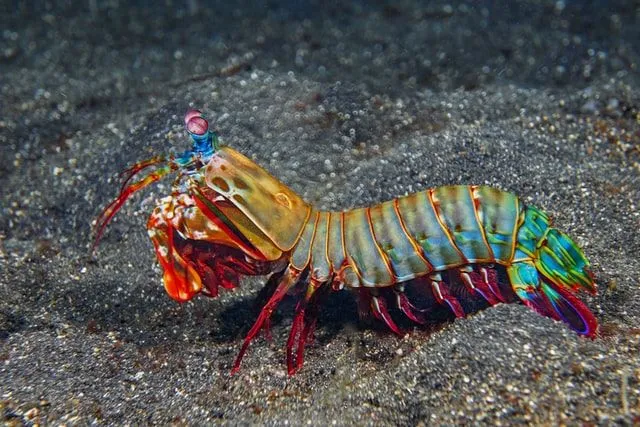FOR ALL AGES
Are you ready for some mind blowing information?
The mantis shrimp is the true definition of small but deadly. These guys are not messing around, they are confident, brightly dressed and born to fight!
Living up to 20 years, and potentially reaching lengths of eighteen inches, not to mention their incredibly high tech eyes and of course their all famous mega shock wave punch, mantis shrimps are one of the most fearsome predators in the entire ocean!
Check out these mind blowing facts about this fierce but fascinating creature, some are hard to believe but they are all true, the mantis shrimp is just incredibly unique.
Once you have been suitably shocked by these mantis shrimp facts, why not continue the interesting creatures theme with some spinosaurus facts and ladybird facts?
If you want to get clued up quickly, check out these snappy facts about the mantis shrimp.
1. Despite their name, these little guys are neither mantises, nor shrimp! They are distantly related to shrimp but are actually part of the stomatopod family.
2. Mantis shrimps evolved from a subclass of crustaceans called malacostraca, so they are distantly related to lobsters, crabs and shrimps who also come from this subclass.
3. Mantis shrimps have been around for nearly 400 million years! About 170 million years before the first dinosaurs existed, these feisty stomatopods were already rocking around on the ocean floor.
4. Mantis shrimp size varies but they usually grow to around four inches in length. Giant mantis shrimp have been known, the largest one recorded was a whopping eighteen inches! If there was ever a shrimp to avoid, it's probably the giant smashing mantis shrimp.
5. Pound for pound, mantis shrimp are one of the strongest creatures in the entire animal kingdom.
6. Mantis shrimps can breed between 20 and 30 times in their lifetime, and they lay hundreds of eggs at once.
7. Mantis shrimp larvae swim about as zooplankton for up to three months, even in this larval stage they already show aggressive behaviour!
8. A mantis shrimp lifespan can be up to 20 years, not bad for an ancient prehistoric ocean insect!

Mantis shrimp are a creature of variety, there are many types to find out about and we have rounded up a few to stir your interest.
9. There are around 450 known species of mantis shrimp.
10. Although there are many variants, there are two main types of mantis shrimp. They fall into one of two categories based on their specialized front claws, and how they use them to kill their prey.
11. Smashers are the more well known of the mantis shrimp species, they have club-like claws that are used like hammers to break the shells of their prey with intense force.
12. Spearers are the other main type of mantis shrimp. The front claws of this variety are very sharp and barbed, and they use them to stab their prey instead of bash!
13. Smashers make their homes within hard rocks or corals and relocate as they grown, whereas spearers like to dig their burrows into the sand, as they grow they can simply dig further into the burrow.
14. Zebra mantis shrimp are a variety of spearer shrimps, they have distinctive black and white stripes all over and also grow to be largest of all, they regularly reach 15 inches in length.
15. Peacock mantis shrimp are by far the most easily recognized, these guys are smashers and can be seen all over the internet beating up various other sea life!
16. The peacock mantis shrimp is also often referred to as the rainbow shrimp, the clown mantis shrimp or sometimes the painted mantis shrimp.
So now we know the mantis shrimp has a violent streak, but just how powerful can they be? Check out these wild facts, you might think you're reading science fiction but they are all true!
17. The smasher mantis shrimp punches with the speed of a 0.22 caliber bullet, this is strong enough to not only break the shells of its prey (ouch!) but also to break aquarium glass! This may explain why this is one of the rarer forms of sea life to spot in captivity.
18. In more scientific terms, the punch of a smasher mantis shrimp can reach an acceleration of 10,400 g-force units, with a velocity of 51 mph. For perspective, that is approximately 50 times faster than the blink of an eye.
19. If a human was able to throw a baseball at the same speed as the mantis shrimp can punch, that baseball could be launched into space!
20. How does the mantis shrimp achieve such force and speed? Within their claws they have a spring, this spring accelerates as they release their club. The force created is an unbelievable 2500 times the mantis shrimp's own weight.
21. If a human being could hit as hard as the mantis shrimp, the force could break steel.
22. The speed at which these punches are delivered also creates another reaction: tiny vapor filled bubbles, also known as cavitation bubbles. When the cavitation bubbles pop, they turn into underwater shock waves. This shock wave then doubles up the punch!
23. When the cavitation bubble implodes it creates a burst of heat that can reach up to 20,000 Kelvin, that is hotter than the sun! Then, as if that isn't enough, this also creates a flash of light known as sonoluminescence.
24. So how does this angry little creature punch this hard without breaking its clubs? This is due to a shock absorbent core within the claw, called a bouligand structure, which has a totally unique molecular structure not seen in any other animal. This structure stops small cracks from getting any bigger and causing the club to break.
25. Part of the shock absorbing properties of their clubs, are layers of elastic chitin. These are fibers that hold the club together in such a way that it can't expand and break on impact. It's very similar to the way boxers will wrap their hands tightly to cope with punches.
26. Scientists have been studying the amazing biology of the mantis shrimps boxing clubs in the hopes of recreating the structures to apply to body armor, aircraft panels and car frames.
27. When the mantis shrimp isn't using its deadly mantis shrimp punch, it will fold its clubbing claw underneath its body to compress the spring.
28. Mantis shrimp have had a few nicknames over the millennia they've been creeping around. The Ancient Assyrians revered to them as 'sea locusts', Australians still call them 'prawn killers', but we think their most apt nickname however could be 'thumb splitters', pretty gruesome!
29. With some species of mantis shrimp, the female will seek out the male to mate. Slightly mysteriously, the male shrimp will only allow the female into their burrow on a full moon as they are much more likely to breed at this time, and less likely to kick the male out.
30. In a modern twist, there are two species of mantis shrimp (the Pullosquilla and Nannosquilla) who will mate for life and raise their eggs together! The female will lay two clutches of eggs and they will each take care of one, or one will become the hunter gatherer, while the other looks after the eggs in burrow.
31. Some colorful mantis shrimp species have biofluorescence, which they use to signal to their potential mate or give off a warning to other shrimp not to get too close.
32. When it comes to disputes, the punching shrimp, unsurprisingly, likes to fight it out! These creatures will resolve their issues through ritualized fighting. They fight by striking one another's highly armored tail plates or telsons.
33. Did you know the mantis shrimp makes a sound? They emit a low grumbling noise similar to a growl!
34. So could a mantis shrimp actually kill a human? With all these totally wild facts about their killer punches it would be easy to think so, but thankfully the chances are slim. It is advisable to avoid getting too close though, just in case.

The mantis shrimp might appear to be a rare creature as they just seem so unusual but actually they are far from rare! They just like to keep to themselves, unless they are fighting off predators or searching for snacks to bash that is.
35. The mantis shrimp like to live in shallow waters of tropical and subtropical regions, they are mostly found in areas of the Pacific and Indian Oceans.
36. Mantis shrimp create complex burrows in the sand or among rocks and coral. They like leave home as little as possible, despite their reputation as angry little firecrackers, these guys like their solitude!
37. With everything we know about mantis shrimps and their tendencies to smash things up, they are often avoided by scientists when it comes to observing in the lab. This is because they eat a lot, they are very hard to catch and, not to mention, they can smash their way out of most tanks.
38. In terms of prey, mantis shrimps most commonly eat crabs, clams, snails, worms, shrimp and fish. Interestingly peacock mantis shrimp happen to be the only predator of the super poisonous blue ring octopus.
39. The main predator that mantis shrimps have to face is humans. They are actually popular as a food in many cuisines including Japanese, Cantonese, Vietnamese, Mediterranean, Filipino and Hawaiian.
40. In Japan there is a dish called Suko where mantis shrimp are boiled and served atop a portion of sushi.
41. Aside from us, sharks and orcas have been known to enjoy a bite of mantis shrimp, and some have been gobbled up by large fish like the bluefin tuna and the barracuda, the main mantis shrimp predators seems to be much much larger creatures that are able to swallow it whole without much warning!
Mantis shrimps have the most complex eyes of all animals in the animal kingdom. Check out these incredible facts about this all seeing prehistoric legend of the sea.
42. Mantis shrimps have compound eyes made up of tens of thousands of tiny individual units. These eyes sit on stalks and can move independently of one another.
43. Mantis shrimp have what is known as trinocular vision, this means that each eye can individually use three separate regions within the eye to establish depth and distance from all directions.
44. Mantis shrimp have 12 to 16 types of highly color-sensitive photoreceptor cells in their eyes, compared to humans who have only three. This gives them the ability to fine tune their color vision as a response to their environments.
45. This also means they can see a huge spectrum of light, ranging from far red light to deep ultraviolet and polarized light. This allows the mantis shrimp to process visual information at high speed, which helps with hunting and avoiding predators too.
46. It has been suggested that mantis shrimp are able to use polarized light as a type of secret communication between themselves, because most predators can't detect it.
47. Fascinatingly, polarized light reflects differently between healthy tissue and cancerous tissue. So scientists are attempting to replicate the mantis shrimps super charged vision in high tech cameras, which could then detect cancer cells.
48. Mantis shrimps high spec eyes also allow them to detect transparent and semi-transparent sea creatures, as well as the scales of the barracuda, which can sneak up quickly and is one of their few predators.
Here at Kidadl, we have carefully created lots of interesting family-friendly facts for everyone to enjoy! If you liked our suggestions for mantis shrimp facts, then why not take a look at these blue crab facts, or toucan facts?
Read The Disclaimer
At Kidadl we pride ourselves on offering families original ideas to make the most of time spent together at home or out and about, wherever you are in the world. We strive to recommend the very best things that are suggested by our community and are things we would do ourselves - our aim is to be the trusted friend to parents.
We try our very best, but cannot guarantee perfection. We will always aim to give you accurate information at the date of publication - however, information does change, so it’s important you do your own research, double-check and make the decision that is right for your family.
Kidadl provides inspiration to entertain and educate your children. We recognise that not all activities and ideas are appropriate and suitable for all children and families or in all circumstances. Our recommended activities are based on age but these are a guide. We recommend that these ideas are used as inspiration, that ideas are undertaken with appropriate adult supervision, and that each adult uses their own discretion and knowledge of their children to consider the safety and suitability.
Kidadl cannot accept liability for the execution of these ideas, and parental supervision is advised at all times, as safety is paramount. Anyone using the information provided by Kidadl does so at their own risk and we can not accept liability if things go wrong.
Kidadl is independent and to make our service free to you the reader we are supported by advertising.
We hope you love our recommendations for products and services! What we suggest is selected independently by the Kidadl team. If you purchase using the buy now button we may earn a small commission. This does not influence our choices. Please note: prices are correct and items are available at the time the article was published.
Kidadl has a number of affiliate partners that we work with including Amazon. Please note that Kidadl is a participant in the Amazon Services LLC Associates Program, an affiliate advertising program designed to provide a means for sites to earn advertising fees by advertising and linking to amazon.
We also link to other websites, but are not responsible for their content.
Was this article helpful?



Browse Category



We’ll send you tons of inspiration to help you find a hidden gem in your local area or plan a big day out.



Check your inbox for your latest news from us. You have subscribed to:
Remember that you can always manage your preferences or unsubscribe through the link at the foot of each newsletter.